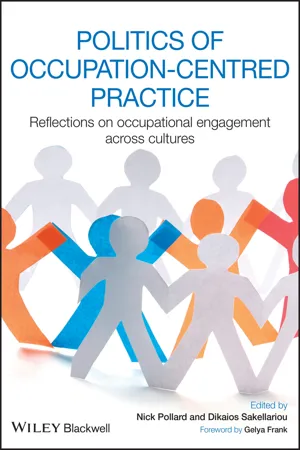Languages & Linguistics
Language and Occupation
"Language and Occupation" refers to the study of how language is used in various occupational settings. This includes examining the specific language and communication patterns within different professions and workplaces, as well as the impact of occupation on language use and development. Understanding language and occupation is important for effective communication and professional success in diverse work environments.
Written by Perlego with AI-assistance
Related key terms
Related key terms
1 of 4
Related key terms
1 of 3
3 Key excerpts on "Language and Occupation"
- eBook - ePub
Doing English Language
A Guide for Students
- Angela Goddard(Author)
- 2012(Publication Date)
- Routledge(Publisher)
4
Areas of Linguistics
The distinctions drawn at the end of chapter 3 should not be taken to mean that English Language is a completely different subject from Linguistics, because the two fields have much in common. Linguistics remains a strong influence on English Language studies and so this chapter sketches in some background to the different fields of Linguistics that have developed since the inception of the subject at higher education level.Two very large areas of Linguistics have developed at the interface between language and the social sciences: Sociolinguistics, which connects Linguistics with Sociology (and with Anthropology, which is closely connected with Sociology); and Psycholinguistics, which connects Linguistics with Psychology.Each of these areas is very wide-ranging, so what you will read about them is necessarily selective. Language and Society, the next section, focuses on ideas about language and social groups, particularly ideas about variation, history, and the politics of language use.Benchmark statementsThe following statements refer particularly to aspects of language and society:The nature and scope of the subject• awareness of the structure and use of geographical, social, and historical varieties of English.Course coverage• historical, geographical, and social variations in English.Subject skills• awareness of the variety of Englishes in the world and intercultural awareness.Language and society
Language variation
As Sociology is the study of society, it makes sense that Sociolinguistics would focus on the relationship between language and social behaviour. A strong element of Sociolinguistics has been that of variation, where studies have attempted to describe how particular groups might differ from each other and from notions of a ‘norm’. An influential figure in this field was William Labov, whose studies of accent variation in New York showed that social identity, particularly in terms of the groups that individuals felt affiliated to or aspired to join, was a factor in determining how they pronounced particular sounds (Labov 1966). Labov’s work showed how small, apparently insignificant language items could act as a shibboleth - eBook - ePub
Politics of Occupation-Centred Practice
Reflections on Occupational Engagement Across Cultures
- Nick Pollard, Dikaios Sakellariou, Nick Pollard, Dikaios Sakellariou(Authors)
- 2012(Publication Date)
- Wiley-Blackwell(Publisher)
Chapter 4 A Grammar for a Language of Occupation Nick Pollard and Dikaios SakellariouIn the language of occupation, grammar occupies a central role of allowing language to function. Grammar provides legibility and stabilizes meaning. It provides the structures that allow the components of doing to be understood, without being so rigid and inflexible as to distort the doing into something unrecognizable. It is the basis on which doing can be dynamic, directed and interconnected.A grammar of doing is not something that is isolated from an interactive and social context. Over the course of their cognitive development people learn by observing and participating and are able to interpret the actions of others from their own experience, just as they are able to develop their use of language from its use in relation to social interaction and environmental cues. Human communication involves the simultaneous translation and exchange of many cues, only some of which are linguistic. Others involve posture, gesture and facial expression in addition to the use or display of objects. A concern with individual doing focuses on only a portion of this interaction and conceptualization of the world. The learning of a language is centred on the individual acquisition of verbal competences but, as anyone who has been educated in a second language knows, the experience of expressing themselves in a social situation outside the classroom is very different. Rapid interactions strain the limitations of a new vocabulary and grammatical rules that are not as embedded as those of a native language. Accent, facial expression, dialect words and other nuances that may not have occurred in the classroom have to be interpreted.Despite these differences, most people can begin to make themselves understood when placed in a foreign social context. One of the most effective ways to learn a second language is immersion in an occupational context where words and actions are clearly related and opportunities to resort to a first language are restricted or denied. The consequence is often that, while the immersed learners develop a knowledge of new words, the vocabulary they acquire is built on the grammar of their first language. These features have become embedded in the various dialect forms of certain languages. Thus it has been claimed that Yorkshire dialect has strong elements of Old Norse and Danish amongst others (Kellett, 1994), Irish forms of English have a grammatical root in Irish (O Muirthe, 1977), and Caribbean patois contains grammatical structures that show their roots in African languages (McLaren, 2009). These differences can become important components of facility for literary expression and for cultural identity (O Muirthe, 1977). Through their use, they signify aspects of cultural identity and belongingness to a community of expression. Despite the recognizable differences and nuances in the usage of certain specific dialect words and grammatical forms that may not occur in other speakers' vocabularies, they share a sufficiently common range of components to be understood most of the time. This facility is due to linguistic competence which some linguistic theorists suggest is innate, and others suggest is learned. Linguistic competence allows individuals to interpret new words and employ them in speech. - eBook - ePub
The Language of Schooling
A Functional Linguistics Perspective
- Mary J. Schleppegrell(Author)
- 2004(Publication Date)
- Routledge(Publisher)
1A better understanding of the ways language construes academic knowledge is important for students and teachers, linguists and language researchers, textbook writers and administrators. This chapter reviews research that demonstrates the ways language socialization practices prepare some children for the contexts of schooling. It also reviews descriptions of school language use that highlight the linguistic choices that are highly valued in school tasks. It is these choices that can be characterized as the language of schooling. The functional linguistic analysis that follows in later chapters links the language features with the social contexts they realize to show the close relationship between language and context, and to illustrate the challenges for students whose socialization has not prepared them to participate fully in the school context.LIFE EXPERIENCE AND LANGUAGE DEVELOPMENT
Language use in the classroom differs from language use in other social situations in many ways. It involves the sharing of ideas and knowledge rather than the sharing of personal relationships and accomplishment of activities together in familiar contexts. Power relationships, expectations for participation, and the forms that discourse takes also differ at home and school. When they go to school, children engage in new kinds of tasks and need to use language for new purposes. Sociolinguistic research has shown that many children come from homes and communities that do not use language in the ways associated with typical school contexts (e.g., Cazden, John, & Hymes, 1972; Heath, 1983; Philips, 1972; Scollon & Scollon, 1981; Watson-Gegeo & Boggs, 1977; see review of studies in Au & Kawahami, 1994). The study of classroom language and its relationship to the social and cultural contexts of home language has demonstrated that there are major discontinuities for many children between language use in school and community. Children from non-mainstream backgrounds have had different experiences and developed different linguistic resources from those that are typically assumed in the school setting.
Index pages curate the most relevant extracts from our library of academic textbooks. They’ve been created using an in-house natural language model (NLM), each adding context and meaning to key research topics.
Explore more topic indexes
Explore more topic indexes
1 of 6
Explore more topic indexes
1 of 4


